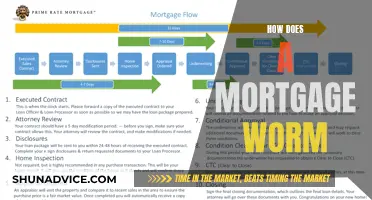
When a person with a mortgage dies, their mortgage debt does not disappear. The process of removing a deceased person from a mortgage depends on several factors, including the type of property ownership, the existence of a will, and the applicable state laws. The surviving spouse or heir may need to assume the mortgage debt or apply for a loan modification. It is essential to notify the mortgage company promptly and seek legal advice to understand the specific steps and requirements for removing a deceased person from a mortgage.
Removing a deceased person from a mortgage
| Characteristics | Values |
|---|---|
| What happens to the mortgage when a spouse dies? | The mortgage debt doesn't vanish when a person dies. The surviving spouse might automatically inherit all of the deceased spouse's property, but not always. |
| What to do after a loved one dies? | Notify the mortgage company of the death as soon as possible. Failing to do so can have financial consequences. |
| What if the deceased had mortgage protection insurance? | The policy will pay off the loan. |
| What if the deceased had a will? | The will specifies who inherits the property. The property is transferred to that person through the probate process. |
| What if the deceased did not have a will? | State law determines who gets the property. |
| What if the surviving spouse wasn't on the mortgage? | Federal law provides protections allowing them to assume the mortgage and keep the home, as long as they can afford the payments. |
| What if the surviving spouse can't afford the payments? | They might have to assume personal liability for the mortgage loan or apply for a loan modification. |
| What if the deceased was the only owner of the property? | Probate or an alternative to probate will be required. |
| What if the deceased co-owned the property? | The surviving owner might have the right of survivorship, in which case the property will pass to them automatically, and there is no need to change the deed. |
| What if there is no right of survivorship? | Legal documentation is needed to transfer the title. Probate may be required. |
| What documents are required to remove a deceased spouse from the deed? | A survivorship affidavit or affidavit of death, death certificate, notarized death affidavit, and a legal description of the property. |
What You'll Learn

The importance of removing a deceased person from a mortgage
The death of a loved one is a difficult time, and the last thing you want is to be burdened with complicated financial matters. However, it is important to address these issues promptly to avoid future complications. One such matter is the removal of a deceased person from a mortgage. While it may seem like a daunting task, it is crucial to understand the importance of this process and take the necessary steps to ensure a smooth transition.
Firstly, it is essential to recognize that mortgage debt does not simply disappear when a person passes away. The surviving spouse or heirs will be responsible for the mortgage payments to avoid financial consequences. By taking timely action, you can prevent issues such as foreclosure and ensure the continuation of payments. This is especially important if the deceased had a mortgage protection insurance policy, which can cover the mortgage payments for a certain period.
Secondly, removing a deceased person from a mortgage is crucial for clear ownership and legal clarity. Without updating the mortgage and deed, the surviving owner may encounter difficulties in selling the house or taking out a new mortgage. A clear and updated deed ensures that the surviving owner has the legal right to make decisions regarding the property. It also simplifies financial matters by ensuring that all obligations related to the property are under the control of the surviving owner, preventing confusion and potential missed payments.
Additionally, addressing the removal of a deceased person from a mortgage is essential for tax purposes. By updating the records, you can avoid receiving property tax bills and notices addressed to the deceased, which can create confusion and lead to potential penalties. It also ensures that the surviving owner is aware of their tax obligations and can take the necessary steps to comply with tax requirements. This can include utilizing a survivorship affidavit, which helps clear up land and tax records by notifying relevant parties of the ownership change.
Furthermore, removing a deceased person from a mortgage can help prevent legal complications in the future. If the surviving owner intends to sell the property or refinance the mortgage, having the deceased's name on the deed can create legal hurdles. It may require probate court approval, leading to time-consuming and costly processes, especially if there are disputes among heirs or creditors. Taking proactive measures to update the mortgage and deed can save time, money, and potential legal headaches down the road.
Lastly, it is important to remember that the process of removing a deceased person from a mortgage can vary depending on the specific circumstances. Factors such as the existence of a will, the type of property ownership, and state laws can all influence the required steps. Seeking legal advice and utilizing platforms that offer guidance and document management can be immensely helpful during this challenging time. Remember, while it may seem overwhelming, taking control of these financial matters is a crucial step towards ensuring a secure future for yourself and your loved ones.
Releasing a Recorded Mortgage in New Jersey
You may want to see also

How to remove a deceased spouse from a deed
When a spouse passes away, the surviving spouse automatically inherits all of the deceased spouse's property. However, this is not always the case. The transfer of ownership depends on the type of ownership (as determined by the deed) and the spouse's estate plan.
If the deed includes survivorship rights, and the surviving spouse is named in the deed, they can use an affidavit of survivorship to remove the deceased spouse from the deed. This is a legal document that records evidence of the deceased spouse's death and clears up land records. It is also known as a survivorship affidavit, affidavit of continuous marriage, or affidavit of surviving spouse.
If the deed does not include survivorship rights, the house will pass through probate as part of the deceased spouse's estate. The probate court will assign an executor, who is responsible for distributing the property, and any outstanding debts of the estate must be paid. The executor will use an executor's deed form to transfer the property to the appropriate beneficiary.
In some cases, the surviving spouse may need to assume the existing mortgage. This is possible if they can afford the mortgage payments. The Garn-St. Germain Act encourages lenders to allow the assumption of a mortgage, and the CFPB has enacted rules to make this easier for surviving spouses.
It is important to note that there is no blanket process for removing a deceased spouse from a house deed, and it is best not to assume that this will happen automatically. It is recommended to verify that the deceased spouse is removed from the deed, as holding the deed to a house is important for the living owner to be able to sell the house or take out a new mortgage.
Missouri Mortgage Recording: A Step-by-Step Guide
You may want to see also

The role of an affidavit of survivorship
When a person dies, their mortgage debt does not disappear. The process of removing a deceased person from a mortgage depends on several factors, including whether the deceased had a will, whether the surviving spouse signed the note and mortgage, and the type of property ownership.
One important document that may be required during this process is an affidavit of survivorship. This legal document is used to remove a deceased owner from the title to a property by recording evidence of their death in the land records. It serves to notify third parties, such as title companies, lenders, and property tax officials, that an owner has passed away and that ownership of the property has been transferred. This document is particularly relevant when the surviving owner was a co-owner or joint tenant with the right of survivorship, tenants by the entirety, or community property with the right of survivorship.
The affidavit of survivorship simplifies the process of updating land and tax records, ensuring that the surviving owner can deal with the property without legal ambiguity. It is worth noting that the right of survivorship varies based on state laws. For example, in community property states, the right of survivorship may be included, but it is not automatic, so it is essential to look for specific phrases in the deed, such as "right of survivorship."
In addition to the affidavit of survivorship, other documents may be required to remove a deceased person from a mortgage and transfer ownership. These can include a certified copy of the death certificate, a legal description of the property, and, in some cases, a grant deed listing the surviving owner(s) as the new owner(s). Seeking legal advice or consulting with a probate attorney can be beneficial to ensure compliance with applicable laws and regulations.
Illinois Mortgage Release: What You Need to Know
You may want to see also

The process of assuming a mortgage from a deceased family member
When a homeowner dies, the inheritance of their home is typically decided by a will or probate proceedings. If the deceased had a will, the document will likely specify who inherits the property. If there is no will, state law determines who gets what. In some cases, the surviving spouse automatically inherits all of the deceased spouse's property, but this is not always the case.
If you inherit a home and decide to keep it, you will also inherit the mortgage debt. However, if the deceased had mortgage protection insurance (MPI), this policy will pay off the loan. Mortgage protection insurance (MPI) covers the mortgage payment for a certain amount of time if the borrower loses their job or becomes disabled, or it pays off the loan in the event of their death.
If the deceased did not have MPI, you can assume the mortgage by following these steps:
- Notify the mortgage company of the death as soon as possible. Failing to do so can have financial consequences, as the lender may foreclose on the home if payments stop.
- Contact the loan servicer to find out about the assumption process.
- Obtain the property's title and lender consent.
- Ensure you can afford to continue making payments. If you cannot, you may need to apply for a loan modification.
- Gather necessary documents, including proof that you are the rightful inheritor of the property or the executor of the estate.
- Transfer the title by obtaining the deed and any other necessary paperwork or authorization.
- If there are multiple heirs or you are not the executor of the will, you may need to sell the home to pay off the mortgage and distribute any leftover funds according to the will or state law.
It is important to note that the process of assuming a mortgage may vary depending on the specific circumstances and state laws. Seeking legal advice can be helpful in navigating this process.

The impact of mortgage protection insurance
When a person with a mortgage dies, the mortgage debt does not disappear. The mortgage is typically passed on to the deceased's spouse, beneficiaries, or heirs, who must then pay off the loan to keep the home. This can be a significant financial burden, especially if the deceased's spouse, beneficiaries, or heirs were not previously on the mortgage.
This is where mortgage protection insurance (MPI) comes in. MPI is like life insurance for your mortgage. It is an insurance policy that pays off the remainder of your mortgage if you die or become disabled and can no longer work. By purchasing MPI, you can ensure that your spouse, beneficiaries, or heirs will not have to worry about paying off the mortgage in the event of your death.
The impact of MPI can be significant. For one, it can provide peace of mind for you and your family, knowing that the mortgage will be taken care of in the event of your death. Additionally, MPI can help your family avoid foreclosure if you can no longer work to pay the mortgage. This can be especially important if your family relies on the income of the deceased to make mortgage payments.
However, there are also some potential drawbacks to MPI. One is that the payoff amount declines as you pay off your mortgage, so you may not benefit as much from MPI if you plan to pay off your mortgage early. Additionally, MPI is paid directly to the lender, so it won't provide any financial protection to your loved ones beyond paying off the mortgage. In this case, a life insurance policy might be a better option, as it would provide a financial cushion for your family to use as they see fit.
Another thing to consider is the cost of MPI. The amount you pay for MPI depends on various factors, including the insurer, the current balance of your mortgage, your age, and the amount of coverage you want. This can add a significant expense to your monthly budget, especially if you are already struggling to make mortgage payments. In some cases, it may be more cost-effective to explore alternatives, such as a piggyback" second mortgage or government-backed loan options that do not require mortgage insurance.
Frequently asked questions
The surviving spouse will likely inherit the property and therefore become the sole owner. However, the mortgage does not simply vanish, and the surviving spouse will need to continue making payments to avoid foreclosure.
If the deceased person was the only owner of the property, probate or an alternative will likely be required. If the deceased was a co-owner, the surviving owner(s) will automatically absorb their share of the property and become the sole owner(s). In this case, there is no need to change the deed, but the mortgage company should be notified as soon as possible.
The process depends on the type of property ownership and the deceased's estate plan. If the deceased was a co-owner, the surviving owner(s) will need to review the deed for language that creates a right of survivorship. This can include terms such as "joint tenants with right of survivorship" or "tenancy by the entirety". If the deceased was the sole owner, the property will likely pass through probate, and an executor will be assigned to distribute it.
A survivorship affidavit, or affidavit of survivorship, is a legal document used to remove a deceased owner from the title of a property. It is used to notify third parties, such as lenders and tax officials, that an owner has passed away and that the property now belongs to the surviving owner(s). An affidavit of heirship, on the other hand, is filed with the county to specify the grantee of the property and facilitate the transfer of ownership.







